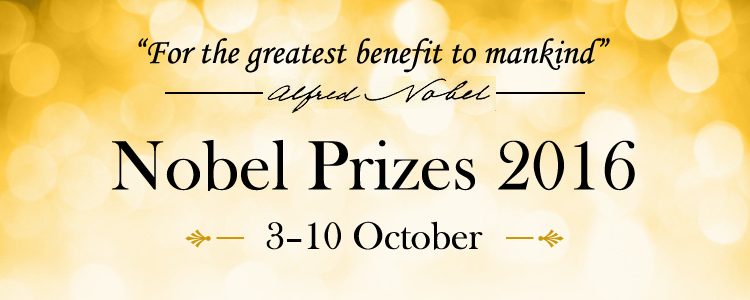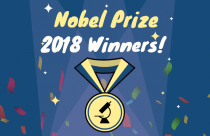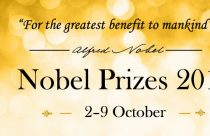2016 Nobel Prizes – Congratulations All Laureates!

The Nobel Prize is the most prestigious award given in recognition of academic, cultural, and/or scientific advances. The Nobel prizes in Chemistry, Literature, Peace, Physics, and Physiology or Medicine were first awarded in 1901. Continuing the age-old tradition, this year too, starting 3 October, a select group of scientists will be in the spotlight for tireless work and dedication in their fields.
Here is a quick checklist on all the facts about the Nobel Prize.
What Does “Nobel Laureate” Mean?
The word “laureate” refers to being signified by the laurel wreath. In ancient Greece, laurel wreaths were awarded to victors as a sign of honor. In layman terms, a Laureate is a person or organization nominated for significant achievement in a particular field, and a Nobel Laureate is someone who has been awarded the Nobel Prize.
Who Nominates and Selects the Nobel Prize Winners?
According to Alfred Nobel’s last will and testament in 1895 and an amendment in 1969, the following institutions are responsible for selecting the Nobel Laureates: The Royal Swedish Academy of Sciences for the Nobel Prize in Physics, Chemistry, and Economic Sciences; The Nobel Assembly at Karolinska Institutet for the Nobel Prize in Physiology or Medicine; The Swedish Academy for the Nobel Prize in Literature; and The Norwegian Nobel Committee for the Nobel Peace Prize.
You can read more about the nomination and selection process here.
Did You Know?
- The Nobel nomination processes begin in the month of September every year.
- Self-nomination for Nobel Prizes is not permitted.
- The names of the nominees cannot be publicly disclosed until 50 years have passed!
- 900 Nobel Laureates so far!—874 individuals and 26 organizations have been awarded the Nobel Prize between 1901 and 2015. Of them, 76 are Laureates in Economic Sciences.
- Nobel Prizes have not been awarded in some years and most of these instances occurred during World Wars I (1914–1918) and II (1939–1945).
- The most common fields for Nobel prize winners in Physics is particle physics, in Chemistry it is biochemistry, in Medicine it is genetics, in Economic Sciences it is macroeconomics, and in Literature it is prose.
You can read more such interesting facts here.
Can Nobel Winners be Predicted?
Among all the speculations for the Nobel honors, Thomson Reuter’s Citation Laureates has been releasing its annual prediction report using citation data from its Web of Science platform to identify highly influential researchers. Of these Citation Laureates, 39 individuals have actually gone on to win a Nobel prize. This count includes the winners of the 2014 and 2015 awards in Physics and Economics—Arthur B McDonald, Angus S. Deaton, Shuji Nakamura, and Jean Tirole.
2016 Announcement Dates*
| Category | Dates of announcement |
| Physiology or Medicine | Monday, 3 October |
| Physics | Tuesday, 4 October |
| Chemistry | Wednesday, 5 October |
| Peace | Friday, 7 October |
| Economic Sciences | Monday, 10 October |
| Literature | Thursday, 13 October |
*Announcements will happen between 11:00 and 11:45 am, Swedish Time.
2016 Nobel Prize Awardees
- Physiology or Medicine: The 2016 Nobel Prize in physiology or medicine went to Yoshinori Ohsumi of Japan for discoveries about autophagy, i.e., how the body breaks down and recycles cellular components. Here is why autophagy matters, courtesy of the Nobel Foundation:
We now know that autophagy controls important physiological functions where cellular components need to be degraded and recycled. Autophagy can rapidly provide fuel for energy and building blocks for renewal of cellular components, and is therefore essential for the cellular response to starvation and other types of stress. After infection, autophagy can eliminate invading intracellular bacteria and viruses. Autophagy contributes to embryo development and cell differentiation. Cells also use autophagy to eliminate damaged proteins and organelles, a quality control mechanism that is critical for counteracting the negative consequences of ageing.
Disrupted autophagy has been linked to Parkinson’s disease, type 2 diabetes and other disorders that appear in the elderly. Mutations in autophagy genes can cause genetic disease. Disturbances in the autophagic machinery have also been linked to cancer. Intense research is now ongoing to develop drugs that can target autophagy in various diseases.
- Physics: The 2016 Nobel Prize in Physics went to David Thouless, Duncan Haldane and Michael Kosterlitz for their work in the field of condensed matter physics. They discovered totally unexpected behaviours of solid materials and came up with a mathematical framework (in the field of topology) to explain these weird properties. The discoveries have paved the way for designing new materials with all sorts of novel properties. The Nobel Foundation shared the following about their research:
This year’s Laureates opened the door on an unknown world where matter can assume strange states. They have used advanced mathematical methods to study unusual phases, or states, of matter, such as superconductors, superfluids or thin magnetic films. Thanks to their pioneering work, the hunt is now on for new and exotic phases of matter. Many people are hopeful of future applications in both materials science and electronics. The three Laureates’ use of topological concepts in physics was decisive for their discoveries. Topology is a branch of mathematics that describes properties that only change step-wise. In the early 1970s, Michael Kosterlitz and David Thouless overturned the then current theory that superconductivity or suprafluidity could not occur in thin layers.
In the 1980s, Thouless was able to explain a previous experiment with very thin electrically conducting layers in which conductance was precisely measured as integer steps. We now know of many topological phases, not only in thin layers and threads, but also in ordinary three-dimensional materials. Over the last decade, this area has boosted frontline research in condensed matter physics, not least because of the hope that topological materials could be used in new generations of electronics and superconductors, or in future quantum computers.
- Chemistry: The 2016 Nobel Prize in Chemistry went to Jean-Pierre Sauvage, Sir J. Fraser Stoddart and Bernard L. Feringa for their design and production of molecular machines. They have developed molecules with controllable movements, which can perform a task when energy is added. The Nobel Foundation shared the following about their research:
The first step towards a molecular machine was taken by Jean-Pierre Sauvage in 1983, when he succeeded in linking two ring-shaped molecules together to form a chain, called a catenane. Normally, molecules are joined by strong covalent bonds in which the atoms share electrons, but in the chain they were instead linked by a freer mechanical bond. For a machine to be able to perform a task it must consist of parts that can move relative to each other. The two interlocked rings fulfilled exactly this requirement.
The second step was taken by Fraser Stoddart in 1991, when he developed a rotaxane. He threaded a molecular ring onto a thin molecular axle and demonstrated that the ring was able to move along the axle. Among his developments based on rotaxanes are a molecular lift, a molecular muscle and a molecule-based computer chip.
Bernard Feringa was the first person to develop a molecular motor; in 1999 he got a molecular rotor blade to spin continually in the same direction. Using molecular motors, he has rotated a glass cylinder that is 10,000 times bigger than the motor and also designed a nanocar.
- Peace: The 2016 Nobel Peace Prize went to Colombian President Juan Manuel Santos for his efforts to bring the 50-year-long civil war to an end, a war that has cost the lives of at least 220 000 Colombians and displaced close to six million people. The Norwegian Nobel Committee shared the following:
The award should also be seen as a tribute to the Colombian people who, despite great hardships and abuses, have not given up hope of a just peace, and to all the parties who have contributed to the peace process. This tribute is paid, not least, to the representatives of the countless victims of the civil war.
President Santos initiated the negotiations that culminated in the peace accord between the Colombian government and the FARC guerrillas, and he has consistently sought to move the peace process forward. Well knowing that the accord was controversial, he was instrumental in ensuring that Colombian voters were able to voice their opinion concerning the peace accord in a referendum. The outcome of the vote was not what President Santos wanted: a narrow majority of the over 13 million Colombians who cast their ballots said no to the accord.
By awarding this year’s Peace Prize to President Juan Manuel Santos, the Norwegian Nobel Committee wishes to encourage all those who are striving to achieve peace, reconciliation and justice in Colombia. The president himself has made it clear that he will continue to work for peace right up until his very last day in office. The Committee hopes that the Peace Prize will give him strength to succeed in this demanding task. Furthermore, it is the Committee’s hope that in the years to come the Colombian people will reap the fruits of the ongoing peace and reconciliation process. Only then will the country be able to address effectively major challenges such as poverty, social injustice and drug-related crime.
- Economics: The Royal Swedish Academy of Sciences has decided to award the Sveriges Riksbank Prize in Economic Sciences in Memory of Alfred Nobel 2016 to Oliver Hart and Bengt Holmström for their contributions to contract theory, a comprehensive framework for analysing many diverse issues in contractual design, like performance-based pay for top executives, deductibles and co-pays in insurance, and the privatisation of public-sector activities. The committee mentioned the following about their contribution:
In the late 1970s, Bengt Holmström demonstrated how a principal (e.g., a company’s shareholders) should design an optimal contract for an agent (the company’s CEO), whose action is partly unobserved by the principal. Holmström’s informativeness principle stated precisely how this contract should link the agent’s pay to performance-relevant information. Using the basic principal-agent model, he showed how the optimal contract carefully weighs risks against incentives. In later work, Holmström generalised these results to more realistic settings, namely: when employees are not only rewarded with pay, but also with potential promotion; when agents expend effort on many tasks, while principals observe only some dimensions of performance; and when individual members of a team can free-ride on the efforts of others.
In the mid-1980s, Oliver Hart made fundamental contri-butions to a new branch of contract theory that deals with the important case of incomplete contracts. Because it is impossible for a contract to specify every eventuality, this branch of the theory spells out optimal allocations of control rights: which party to the contract should be entitled to make decisions in which circumstances? Hart’s findings on incomplete contracts have shed new light on the ownership and control of businesses and have had a vast impact on several fields of economics, as well as political science and law. His research provides us with new theoretical tools for studying questions such as which kinds of companies should merge, the proper mix of debt and equity financing, and when institutions such as schools or prisons ought to be privately or publicly owned.
- Literature: The Swedish Academy has decided to award the Nobel Prize in Literature to Bob Dylan for having created new poetic expressions within the great American song tradition. The permanent secretary of The Swedish Academy mentioned the following:
Dylan had been chosen because he was “a great poet in the English speaking tradition.” For 54 years now he’s been at it reinventing himself, constantly creating a new identity. Although the choice might seem surprising, if you look far back, 5000 years, you discover Homer and Sappho. They wrote poetic texts which were meant to be performed, and it’s the same way for Bob Dylan. We still read Homer and Sappho, and we enjoy it.
The Nobel Prize in Literature concludes the series of Nobel Prize announcements. These awards will now be presented on 10 December, the 120th anniversary of prize founder Alfred Nobel’s 1896 death.
- Announcement of Nobel Prize in Physiology or Medicine
- Announcement of Nobel Prize in Physics
- Announcement of the Nobel Prize in Chemistry
- Announcement of the Nobel Peace Prize
- Announcement of the Nobel Prize in Economic Sciences
- Announcement of the Nobel Prize in Literature









